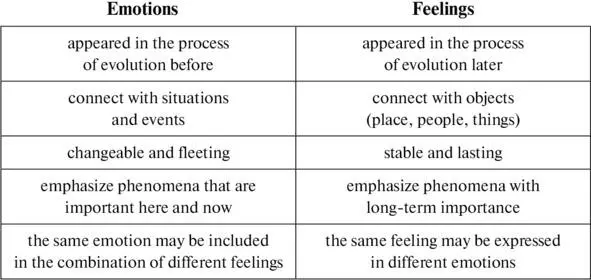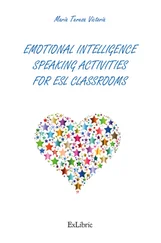1 ...8 9 10 12 13 14 ...20 3. Each need has special values that may conflict, or contradict each other.
4. Knowledge of our values and their hierarchy can resolve internal conflicts, set true goals.
5. The saturation of life with true values leads to a feeling of happiness.
6. Happiness is a real satisfaction with oneself and one’s life.
Emotions are a mental process grabbing the whole person, which change his thoughts, biochemistry, sensations and behavior. As have already been mentioned, the purpose of emotions is to establish the significance of certain conditions to meet actual needs. Based on emotions, we unconsciously conclude whether there is anything valuable in the upcoming event or phenomenon and make a decision how to act.
For example, you are invited to a birthday, immediately there is an emotion of either desire or resistance. It most likely depends on how much communication with this person satisfies your needs. If the communication with him satisfies your needs, you will agree, if not, you will find a reason to refuse. But it happens that the person who invites you is unpleasant in communicating, but you think that he can affect your life, and communicating with him will bring satisfaction to needs in the future. Then you will feel several emotions at once, which will unite into a single feeling.
Feelings are emotions of a higher order. Their goal is to single out phenomena that have stable motivating significance.
Let’s compare feelings and emotions, what are their differences.
Emotions and feelings arose in the process of evolution, but feelings are associated with the ability to think, reason and draw conclusions, and only the modern part of the brain – the neocortex is capable of this. Emotions are born in the more ancient part of our brain – in the limbic system.
Emotions show us what is important for us now, while feelings indicate a direction towards unchanging values.
Emotions are fleeting, they can change dozens of times per minute, if it is eventful. Feelings are very stable, they are based on deep convictions and they are not so easy to shake and change.

There is a simple example: a person can sit in a comfortable apartment with a loved one, experience emotions of joy and tenderness, but feel fear in the background, as changes are coming at work, and this situation according to the personal experience and beliefs, does not lead to anything good.
A feeling can contain one and many emotions at the same time and can express any of them. For example, a person may experience a surge of tenderness when he sees a small kitten – it will be an emotion. And if he always feels tenderness at the sight of any kitten, as he had a cat in childhood and convinces that there is nothing nicer in the world, so this is a feeling. This is an example where a feeling contains one emotion, and that’s why the external expression of a feeling and an emotion will coincide.
It is more difficult when the feeling is multi-component and contains several emotions. For example, guilt contains 4 emotions: fear, anger, sadness, desire. A person experiencing this feeling can express it through any of these emotions. For example, his emotional habit may be an expression of the emotion of anger when he feels guilty. Feeling guilty is very uncomfortable for living, a person experiences unpleasant sensations, so he often wants to run away from them, in this example, to anger. It will seem that such a person does not feel guilty, that he is angry, but this is not true. Another emotional habit is to express guilt through sadness, then a person seeks to retire, dive in himself, cry and do nothing. Sometimes it seems that the mood is changeable, as the expressed emotions can replace each other in a chaotic manner. So a guilty person can first swear loudly, then shut himself up and even cry, the next moment run away, afraid of punishment, then swear and scream again, and at some point become too helpful to compensate for the damage.
In general, feelings of guilt and resentment deserve special attention and a separate chapter, as they monitor the implementation of the system law, which we will consider later.
Let’s first understand what emotions tell us. Everything is actually very simple if you read and use the information that emotions convey to us from the present moment, right here and now. If you do not understand your emotions and ignore them, then they are woven into tangles of emotional tension and turn into multi-component feelings that are difficult to understand without special knowledge and training.
At first, there are many psychological models that offer different emotions as basic ones. We suggest taking emotions that differ in internal sensations. Our task is to learn to distinguish them within ourselves, and then to learn how to express them in such a way as to live them in the present moment and not to pull a long emotional train through our lives. Darwin also identified 7 basic emotions: fear, anger, sadness, disgust, shame, surprise. After a while, S.S. Tomkins added interest to this list, and A. Lowen added tenderness as an experience of agreement and acceptance.
1. Joy
2. Desire
3. Tenderness
4. Surprise
5. Sadness
6. Anger
7. Disgust
8. Shame
9. Fear
These are 9 emotions that are very different in their internal sensations according to various criteria, 8 of which carry information about the current state of person’s psychological needs, define the direction for actions and release energy for them. Five of them we call the emotions of scarcity (when we are missing something) – these are fear, anger, shame, disgust, sadness; and tenderness, joy, desire are emotions of fulfillment (when we get what we need). There is an important emotion to remember —surprise. We did not include it in the composition of neither emotions of fulfillment, nor scarcity, since it does not carry information about the state of psychological needs, but it is important for our development and is transitional between them. Surprise tells us that we met with something that we did not expect and it is part of such feelings and conditions as insight, awareness, consciousness, etc.
Any feeling consists of these 9 emotions. It is like a palette of paints of primary colors, combining which in different proportions, you can get an unlimited variety of shades.
As colors have saturation, and emotions have intensity. People do not often have enough words to name their emotions, there are some ways to name these emotions in different intensities:
Fear
Fear, numbness, nightmare, panic, horror, dread, perplexity, confusion, misgiving, excitement, frustration, anxiety, worry, fear, commotion, doubt, fright, surprise, uncertainty, indecision, funk.
Anger
Anger, wrath, rage, fury, indignation, resistance, resentment, bitterness, rampage, irritation, aggression, discontent, protest.
Shame
Shame, awkwardness, shyness, embarrassment, inferiority, disgrace, absurdity, worthlessness.
Disgust
Disgust, rejection, hostility, antipathy, nausea, loathing, aversion, abomination.
Sadness
Sadness, loneliness, hopelessness, boredom, indifference, laziness, pain, melancholy, bitterness, doom, grief, meaninglessness, unhappiness, longing, apathy, frustration, despondency, emptiness, frustration.
Desire
Desire, urge, interest, motivation, curiosity, aspiration, inspiration, impatience, attraction, thirst.
Joy
Joy, happiness, pleasure, peace, satisfaction, fun, delight, calm, euphoria, ecstasy, relief, bliss, enjoyment, lightness.
Читать дальше













